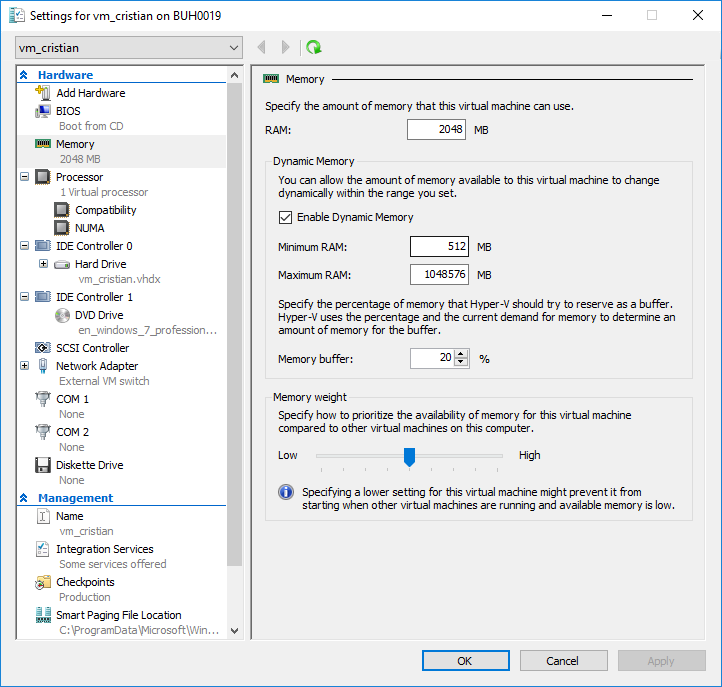According to the latest Gartner report regarding x86 Server Virtualization Infrastructure, about 80% of server workloads are virtualized, and Hyper-V platform is among the leaders in the area of virtualization. Have you ever wondered why server virtualization became so popular? Today, I will share a few advantages because of which companies should really consider Hyper-V virtualization in order to not be in the 20% of non-virtualized (legacy) organizations.
Higher hardware utilization
The biggest issue of on-premises data centers, which have dedicated servers for each workflow, is very low hardware utilization. Companies simply can’t afford to run out of server capacity because their line-of-business (LOB) applications will work slowly or even stop, which is going to impact their revenues, so they oversize their hardware. Resource utilization of such servers is usually below 20% — they are not used at their full potential. So how can you benefit from higher utilization of your expensive servers? Yes, virtualization is the answer. Theoretically, on the physical server that hosts an application you can implement five of the same servers as VMs (five servers with 20% utilization). Each application can have its own isolated environment, or several, for multi-tier application. In practice, there are more aspects to consider, like redundancy or VM peaks. With Hyper-V, you can consolidate more workloads within one server and take full advantage of your hardware.
Better flexibility
One of the greatest benefits of Hyper-V is its flexibility. For example, if at the end of the month, my SQL server requires more resources to quickly generate reports, it’s just a matter of a few clicks to add (or remove) required resources, such as CPU, memory or storage. This type of operation is much more difficult, sometimes even impossible, to achieve in non-virtualized environments. And what’s more, this process can be automated!

Additionally, virtualization can give you the advantage of mobility. Since OS and applications inside a VM are not stuck to the host, they can be easily moved to another host within a cluster with no need to reinstall everything on a new machine. Also, you can move a VM to a new, faster server without application disruption, ensuring high Availability for your infrastructure and saving a lot of time.

Cost savings
Often, companies experience budget overruns due to resource utilization. With more hardware utilization under hypervisors, you don’t need as many dedicated physical servers for your LOB applications. So instead of buying dedicated hardware, you can invest in a few servers for Hyper-V and virtualize all workloads. This leads to less hardware purchases and, consequently, less required space for it, less power consumption and so on.
We are talking about virtualization, so let’s see what the additional cost is for it. Besides hardware, the cost of virtualization is usually the cost of the hypervisor or hypervisor license. There are many hypervisors, like Microsoft Hyper-V, VMware ESXi, Citrix XenServer and RedHat Enterprise Virtualization. However, if most of your infrastructure is based on Windows Server OS, then Hyper-V is probably the best option for you as it’s already part of the Windows Server license. To enable Hyper-V, you just need to select a checkbox in the Add/Remove features menu. Usually, the built-in features of Windows Server are enough, which makes cost benefits visible for either small or larger infrastructures. Another advantage is the minimal cost of training — Hyper-V is based on Windows, and management should be easy to understand and handle by Windows Server administrators. For large environments though, additional management could be required, which can be done by Microsoft System Center — and the cost will only be the price of the additional software.

Disaster recovery
Catastrophic failure can always occur, be it a hardware breakdown, a software issue or the human factor. That’s why it’s important to have a disaster recovery (DR) environment where you can easily fail over if you experience issues with your main site. As a secondary data center, you can use popular public clouds (i.e. Microsoft Azure) or another data center located in a different part of your city, another country or even around the world. Building such an environment is easy with Hyper-V — the VMs can be replicated to the DR site with Hyper-V Replica or third-party applications. When replication is active, production changes are transferred to the replica VM according to a schedule, so then you can fail over VMs to the second site once required. You can also verify if replicas are reliable by testing them with a few simple steps. Bottom line, with Hyper-V you can have a great replication solution for your VMs at an affordable price.
Disadvantages
Of course virtualization has some drawbacks too. A highly-loaded database on a dedicated database server is slightly faster than one on the VM, due to the hypervisor overlay. But the truth is that this occurs only in special usage conditions, and even though the database on the physical server will probably have better performance, the difference is so small as to be negligible.
Another drawback of virtualization is applications with specific requirements. For example, Microsoft Clusters, Oracle RAC — applications with guest clustering or applications which rely on hardware components that cannot be virtualized — wouldn’t make good candidates for virtualization.
So with many VMs on your server, what’s going to become a critical part of the infrastructure? Yes, the host. If the host fails, then all the VMs on that server will stop working. That’s why a healthy hypervisor implementation should also have high Availability (can be done by host clustering), backups and an efficient DR plan (can be done by Hyper-V Replica or in a more advanced way by Veeam Backup & Replication).

